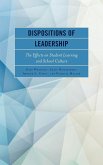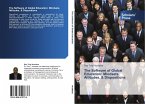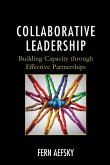Gary Whiteley, Lexie Domaradzki, Arthur L. Costa
Dispositions of Leadership
The Effects on Student Learning and School Culture
Gary Whiteley, Lexie Domaradzki, Arthur L. Costa
Dispositions of Leadership
The Effects on Student Learning and School Culture
- Broschiertes Buch
- Merkliste
- Auf die Merkliste
- Bewerten Bewerten
- Teilen
- Produkt teilen
- Produkterinnerung
- Produkterinnerung
This book challenges the utility of traditional command-and-control models that are no longer capable of supporting school leaders and describes how an effective educational leader in the Information Age applies dispositional thinking in order to be adaptive, self-aware and responsive to others.
Andere Kunden interessierten sich auch für
![Dispositions of Leadership Dispositions of Leadership]() Lexie DomaradzkiDispositions of Leadership102,99 €
Lexie DomaradzkiDispositions of Leadership102,99 €![The Software of Global Education: Mindsets, Attitudes, & Dispositions The Software of Global Education: Mindsets, Attitudes, & Dispositions]() Ras Tsidi AcolatseThe Software of Global Education: Mindsets, Attitudes, & Dispositions45,99 €
Ras Tsidi AcolatseThe Software of Global Education: Mindsets, Attitudes, & Dispositions45,99 €![Collaborative Leadership Collaborative Leadership]() Fern AefskyCollaborative Leadership35,99 €
Fern AefskyCollaborative Leadership35,99 €![Ethics and Politics in School Leadership Ethics and Politics in School Leadership]() Jeffrey BriertonEthics and Politics in School Leadership92,99 €
Jeffrey BriertonEthics and Politics in School Leadership92,99 €![Futures Based Change Leadership Futures Based Change Leadership]() Richard BernatoFutures Based Change Leadership59,99 €
Richard BernatoFutures Based Change Leadership59,99 €![Powerless to Powerful Powerless to Powerful]() Charles SalinaPowerless to Powerful36,99 €
Charles SalinaPowerless to Powerful36,99 €![Politically Intelligent Leader Politically Intelligent Leader]() Patricia Clark WhitePolitically Intelligent Leader47,99 €
Patricia Clark WhitePolitically Intelligent Leader47,99 €-
-
-
This book challenges the utility of traditional command-and-control models that are no longer capable of supporting school leaders and describes how an effective educational leader in the Information Age applies dispositional thinking in order to be adaptive, self-aware and responsive to others.
Produktdetails
- Produktdetails
- Verlag: Rowman & Littlefield Publishers
- Seitenzahl: 208
- Erscheinungstermin: 10. August 2017
- Englisch
- Abmessung: 229mm x 152mm x 12mm
- Gewicht: 346g
- ISBN-13: 9781475836264
- ISBN-10: 1475836260
- Artikelnr.: 48136020
- Herstellerkennzeichnung
- Libri GmbH
- Europaallee 1
- 36244 Bad Hersfeld
- gpsr@libri.de
- Verlag: Rowman & Littlefield Publishers
- Seitenzahl: 208
- Erscheinungstermin: 10. August 2017
- Englisch
- Abmessung: 229mm x 152mm x 12mm
- Gewicht: 346g
- ISBN-13: 9781475836264
- ISBN-10: 1475836260
- Artikelnr.: 48136020
- Herstellerkennzeichnung
- Libri GmbH
- Europaallee 1
- 36244 Bad Hersfeld
- gpsr@libri.de
Gary Whiteley has been a medical laboratory technician, truck driver, residential home builder, painter, commercial fisher, university residence hall director, and hockey coach. Gary has also been an educator for forty-two years. He served in roles at the school level and district level, including classroom teacher, assistant principal, school principal, and assistant superintendent. Gary earned a doctorate in educational leadership at the University of Maine. He developed and facilitated mentoring programs that served school principals and superintendents for the Alaska Department of Education and Early Development. Gary designed and implemented two statewide leadership programs in Idaho for school principals. He was a leadership consultant for the Education Commission of the States for five years. Gary resides in Alaska-the Great Land-where the impact of global climate change is unavoidable.
Dedication
List of Figures
List of Tables
Foreword
Preface
Acknowledgements
Introduction
Complexity of the Contemporary Educational System
Why Are New Understandings of Educational Leadership Needed?
Learning Environments and the Need for Adaptive Competence
Habits of Mind or Dispositions
Educational Leadership in the Information Age
Overview of the Book
Questions to Engage your Thinking and Discussion with Colleagues
References
Chapter One: What Effect Does Educational Leadership Have on Student
Learning?
The Century-Long Evolution of Educational Leadership
Twenty-five Important Works in Five Tables
Efficiency, Bureaucracy, and the Heroic Leader - 1911-1967
Transformational Leadership and the Learning Organization - 1978-1990
Adaptive Leadership a Response for Addressing Complexity - 1993-2003
The Agile Organization and Adaptive Leadership - 2005-2009
A Home of Our Own Emerges: Leading Linked with Student Learning - 2011-
2013
Summary of the Five Tables and 25 Important Books for Leadership and
Learning
A New Era of Leadership with Student Learning as the Pervasive Focus
Leadership Dimensions and Core Leadership Practices: Broader-Grained Work
The Three Capabilities and Four Pathways: Finer-Grained Leadership Work
Summary
Questions to Engage Your Thinking and Discussion with Colleagues
References
Chapter Two: How Does an Agile Organization Support Contemporary School
Leadership?
The Formal Organization: An Overview
Formal Organization: Routine Analytical and Routine Cognitive Problem
Solving
Agile Organizations: Adapting the Formal Organization to Meet 21st Century
Needs
Agile Organizations: Non-Routine Analytical and Interactive Problem Solving
Asserting Focus Amidst Complexity: A Challenge in the Information Age
Agility: Identifying the Type of Problem or Challenge
Technical Problems, Adaptive Challenges, and Polarity Management
Network-centric Collaborative Groups, Agility, and Decision-making
High-Performing Principal Teams and School-based Leadership Teams
Summary
Questions to Engage your Thinking and Discussion with Colleagues
References
Chapter Three: What Are the Dispositions of Contemporary Educational
Leadership?
What are Dispositions?
Why Dispositions?
Dispositions for Educational Leadership
What Roles Do Dispositions Serve in Leadership?
How are Dispositions Acquired?
Why Consider Utilizing Thinking Dispositions with Educators?
Dispositions Build the School Culture
The Five Dispositions of Leadership
Dispositions, Capabilities, and Practices: Ways of Thinking, Being, Doing
The Balcony and the Dance Floor
Summary
Questions to Engage your Thinking and Discussion with Colleagues:
References
Chapter Four: Disposition: Thinking and Acting Interdependently
Capability One: Establishing and Maintaining an Environment of Trust that
Includes Predictable Values and Predictable Skills
Capability Two: Identifying, Articulating, and Aligning with a Shared
Vision that Addresses a Pervasive Focus on Student and Adult Learning
Capability Three: Promote a Group of Diverse Individuals to Access and
Utilize Resources and Expertise Across a Broader Community
Capability Four: Setting Aside Your Own Preferences for the Benefit of All
Capability Five: Having the Capacity to Look at Things from Others' Point
of View
Capability Six: Anticipating Ways to Support Others in the Collaborative
Process
Summary
Middle School Vignette
Questions to Engage your Thinking and Discussion with Colleagues
References
Chapter Five: Communicating to Influence
Capability One: Developing the Capabilities within Others to Interact
Successfully
Discussion
Dialogue
Capability Two: Developing Personal Presence
Capability Three: Knowing When and Why to Integrate and Knowing When to
Insert Oneself
Capability Four: Use Interpersonal Skills to Cultivate Working
Relationships and to Motivate and Mobilize Others (Individuals and Groups)
Summary
Middle-school Vignette
Questions to Engage your Thinking and Discussion with Colleagues
References
Chapter Six: Gathering and Applying Information for Change
Capability One: Systematically and Intentionally Gathering and Organizing
Needed Data
Academic Content and Measures of Schooling
Student Engagement in the Behavior, Emotional, And Cognitive Dimensions
Information Collected for Evaluating Implementation Topics
Capability Two: Using data to inform actions
Capability Three: Developing and Nurturing an Environment of Inquiry and
Innovation Grounded in Reflection and Continuous Improvement
Summary
Middle School Vignette
Questions to Engage Your Thinking and Discussion with Colleagues
References
Chapter Seven: Seeking Support for Feedback and Learning
Capability One: Developing Self-Knowledge, Self-Awareness and Self-Efficacy
While Maintaining a Sense of Humility
Capability Two: Frequently Seeking Feedback Focused on Learning and
Professional Growth
Capability Three: Engaging in a Collegial Networked Leadership Community of
High-Performing Teams of Principals
Problems of Practice Versus Practice-Based Evidence
Effective Networked Leadership Communities
Relationship Between Support, Resiliency, Feedback and Excellence
Professional Goal Setting
Capability Four: Creating Feedback Spirals for Continuous Individual and
Organizational Self-Learning
Receiving Feedback
Giving Feedback
Summary
Middle School Vignette
Questions to Engage Your Thinking and Discussion with Colleagues
Chapter Eight: Pursuing Adaptive Competence
What is Adaptive Competence?
Pursuing Adaptive Competence in Ambiguous Environments
Capability One: Using Self-Managing, Self-Monitoring, and Self-Modifying
Skills to Inform Behaviors and Actions
Capability Two: Engaging Flexibly in Thinking and Behaviors
Capability Three: Solving Complex Problems and Addressing Adaptive
Challenges
Summary
Middle School Vignette: Three Middle School Principals
Questions to Engage Your Thinking and Discussion with Colleagues:
References
Chapter Nine: Discovering Leadership Potential in an Agile Organization
Five Dispositions of Leadership:
Thinking and Acting Interdependently: Promoting a positive, collaborative
learning culture through distributed leadership.Communicating to Influence:
Developing the interpersonal skills to influence, mobilize and motivate
individuals and groups.Gathering and Appling Information for Change:
Utilizing data-based evidence to make decisions and provide formative
feedback for setting direction and planning change.Seeking Support and
Feedback for Learning: Fostering personal/professional growth and
resiliency. Pursuing Adaptive Competence (Keystone Disposition):
Incorporating into practice metacognition and cognitive flexibility to
effectively plan, reflect, diagnose, and solve complex problems. Feedback:
A Networked Leadership Community Vignette
Questions for Reflection
List of Figures
List of Tables
Foreword
Preface
Acknowledgements
Introduction
Complexity of the Contemporary Educational System
Why Are New Understandings of Educational Leadership Needed?
Learning Environments and the Need for Adaptive Competence
Habits of Mind or Dispositions
Educational Leadership in the Information Age
Overview of the Book
Questions to Engage your Thinking and Discussion with Colleagues
References
Chapter One: What Effect Does Educational Leadership Have on Student
Learning?
The Century-Long Evolution of Educational Leadership
Twenty-five Important Works in Five Tables
Efficiency, Bureaucracy, and the Heroic Leader - 1911-1967
Transformational Leadership and the Learning Organization - 1978-1990
Adaptive Leadership a Response for Addressing Complexity - 1993-2003
The Agile Organization and Adaptive Leadership - 2005-2009
A Home of Our Own Emerges: Leading Linked with Student Learning - 2011-
2013
Summary of the Five Tables and 25 Important Books for Leadership and
Learning
A New Era of Leadership with Student Learning as the Pervasive Focus
Leadership Dimensions and Core Leadership Practices: Broader-Grained Work
The Three Capabilities and Four Pathways: Finer-Grained Leadership Work
Summary
Questions to Engage Your Thinking and Discussion with Colleagues
References
Chapter Two: How Does an Agile Organization Support Contemporary School
Leadership?
The Formal Organization: An Overview
Formal Organization: Routine Analytical and Routine Cognitive Problem
Solving
Agile Organizations: Adapting the Formal Organization to Meet 21st Century
Needs
Agile Organizations: Non-Routine Analytical and Interactive Problem Solving
Asserting Focus Amidst Complexity: A Challenge in the Information Age
Agility: Identifying the Type of Problem or Challenge
Technical Problems, Adaptive Challenges, and Polarity Management
Network-centric Collaborative Groups, Agility, and Decision-making
High-Performing Principal Teams and School-based Leadership Teams
Summary
Questions to Engage your Thinking and Discussion with Colleagues
References
Chapter Three: What Are the Dispositions of Contemporary Educational
Leadership?
What are Dispositions?
Why Dispositions?
Dispositions for Educational Leadership
What Roles Do Dispositions Serve in Leadership?
How are Dispositions Acquired?
Why Consider Utilizing Thinking Dispositions with Educators?
Dispositions Build the School Culture
The Five Dispositions of Leadership
Dispositions, Capabilities, and Practices: Ways of Thinking, Being, Doing
The Balcony and the Dance Floor
Summary
Questions to Engage your Thinking and Discussion with Colleagues:
References
Chapter Four: Disposition: Thinking and Acting Interdependently
Capability One: Establishing and Maintaining an Environment of Trust that
Includes Predictable Values and Predictable Skills
Capability Two: Identifying, Articulating, and Aligning with a Shared
Vision that Addresses a Pervasive Focus on Student and Adult Learning
Capability Three: Promote a Group of Diverse Individuals to Access and
Utilize Resources and Expertise Across a Broader Community
Capability Four: Setting Aside Your Own Preferences for the Benefit of All
Capability Five: Having the Capacity to Look at Things from Others' Point
of View
Capability Six: Anticipating Ways to Support Others in the Collaborative
Process
Summary
Middle School Vignette
Questions to Engage your Thinking and Discussion with Colleagues
References
Chapter Five: Communicating to Influence
Capability One: Developing the Capabilities within Others to Interact
Successfully
Discussion
Dialogue
Capability Two: Developing Personal Presence
Capability Three: Knowing When and Why to Integrate and Knowing When to
Insert Oneself
Capability Four: Use Interpersonal Skills to Cultivate Working
Relationships and to Motivate and Mobilize Others (Individuals and Groups)
Summary
Middle-school Vignette
Questions to Engage your Thinking and Discussion with Colleagues
References
Chapter Six: Gathering and Applying Information for Change
Capability One: Systematically and Intentionally Gathering and Organizing
Needed Data
Academic Content and Measures of Schooling
Student Engagement in the Behavior, Emotional, And Cognitive Dimensions
Information Collected for Evaluating Implementation Topics
Capability Two: Using data to inform actions
Capability Three: Developing and Nurturing an Environment of Inquiry and
Innovation Grounded in Reflection and Continuous Improvement
Summary
Middle School Vignette
Questions to Engage Your Thinking and Discussion with Colleagues
References
Chapter Seven: Seeking Support for Feedback and Learning
Capability One: Developing Self-Knowledge, Self-Awareness and Self-Efficacy
While Maintaining a Sense of Humility
Capability Two: Frequently Seeking Feedback Focused on Learning and
Professional Growth
Capability Three: Engaging in a Collegial Networked Leadership Community of
High-Performing Teams of Principals
Problems of Practice Versus Practice-Based Evidence
Effective Networked Leadership Communities
Relationship Between Support, Resiliency, Feedback and Excellence
Professional Goal Setting
Capability Four: Creating Feedback Spirals for Continuous Individual and
Organizational Self-Learning
Receiving Feedback
Giving Feedback
Summary
Middle School Vignette
Questions to Engage Your Thinking and Discussion with Colleagues
Chapter Eight: Pursuing Adaptive Competence
What is Adaptive Competence?
Pursuing Adaptive Competence in Ambiguous Environments
Capability One: Using Self-Managing, Self-Monitoring, and Self-Modifying
Skills to Inform Behaviors and Actions
Capability Two: Engaging Flexibly in Thinking and Behaviors
Capability Three: Solving Complex Problems and Addressing Adaptive
Challenges
Summary
Middle School Vignette: Three Middle School Principals
Questions to Engage Your Thinking and Discussion with Colleagues:
References
Chapter Nine: Discovering Leadership Potential in an Agile Organization
Five Dispositions of Leadership:
Thinking and Acting Interdependently: Promoting a positive, collaborative
learning culture through distributed leadership.Communicating to Influence:
Developing the interpersonal skills to influence, mobilize and motivate
individuals and groups.Gathering and Appling Information for Change:
Utilizing data-based evidence to make decisions and provide formative
feedback for setting direction and planning change.Seeking Support and
Feedback for Learning: Fostering personal/professional growth and
resiliency. Pursuing Adaptive Competence (Keystone Disposition):
Incorporating into practice metacognition and cognitive flexibility to
effectively plan, reflect, diagnose, and solve complex problems. Feedback:
A Networked Leadership Community Vignette
Questions for Reflection
Dedication
List of Figures
List of Tables
Foreword
Preface
Acknowledgements
Introduction
Complexity of the Contemporary Educational System
Why Are New Understandings of Educational Leadership Needed?
Learning Environments and the Need for Adaptive Competence
Habits of Mind or Dispositions
Educational Leadership in the Information Age
Overview of the Book
Questions to Engage your Thinking and Discussion with Colleagues
References
Chapter One: What Effect Does Educational Leadership Have on Student
Learning?
The Century-Long Evolution of Educational Leadership
Twenty-five Important Works in Five Tables
Efficiency, Bureaucracy, and the Heroic Leader - 1911-1967
Transformational Leadership and the Learning Organization - 1978-1990
Adaptive Leadership a Response for Addressing Complexity - 1993-2003
The Agile Organization and Adaptive Leadership - 2005-2009
A Home of Our Own Emerges: Leading Linked with Student Learning - 2011-
2013
Summary of the Five Tables and 25 Important Books for Leadership and
Learning
A New Era of Leadership with Student Learning as the Pervasive Focus
Leadership Dimensions and Core Leadership Practices: Broader-Grained Work
The Three Capabilities and Four Pathways: Finer-Grained Leadership Work
Summary
Questions to Engage Your Thinking and Discussion with Colleagues
References
Chapter Two: How Does an Agile Organization Support Contemporary School
Leadership?
The Formal Organization: An Overview
Formal Organization: Routine Analytical and Routine Cognitive Problem
Solving
Agile Organizations: Adapting the Formal Organization to Meet 21st Century
Needs
Agile Organizations: Non-Routine Analytical and Interactive Problem Solving
Asserting Focus Amidst Complexity: A Challenge in the Information Age
Agility: Identifying the Type of Problem or Challenge
Technical Problems, Adaptive Challenges, and Polarity Management
Network-centric Collaborative Groups, Agility, and Decision-making
High-Performing Principal Teams and School-based Leadership Teams
Summary
Questions to Engage your Thinking and Discussion with Colleagues
References
Chapter Three: What Are the Dispositions of Contemporary Educational
Leadership?
What are Dispositions?
Why Dispositions?
Dispositions for Educational Leadership
What Roles Do Dispositions Serve in Leadership?
How are Dispositions Acquired?
Why Consider Utilizing Thinking Dispositions with Educators?
Dispositions Build the School Culture
The Five Dispositions of Leadership
Dispositions, Capabilities, and Practices: Ways of Thinking, Being, Doing
The Balcony and the Dance Floor
Summary
Questions to Engage your Thinking and Discussion with Colleagues:
References
Chapter Four: Disposition: Thinking and Acting Interdependently
Capability One: Establishing and Maintaining an Environment of Trust that
Includes Predictable Values and Predictable Skills
Capability Two: Identifying, Articulating, and Aligning with a Shared
Vision that Addresses a Pervasive Focus on Student and Adult Learning
Capability Three: Promote a Group of Diverse Individuals to Access and
Utilize Resources and Expertise Across a Broader Community
Capability Four: Setting Aside Your Own Preferences for the Benefit of All
Capability Five: Having the Capacity to Look at Things from Others' Point
of View
Capability Six: Anticipating Ways to Support Others in the Collaborative
Process
Summary
Middle School Vignette
Questions to Engage your Thinking and Discussion with Colleagues
References
Chapter Five: Communicating to Influence
Capability One: Developing the Capabilities within Others to Interact
Successfully
Discussion
Dialogue
Capability Two: Developing Personal Presence
Capability Three: Knowing When and Why to Integrate and Knowing When to
Insert Oneself
Capability Four: Use Interpersonal Skills to Cultivate Working
Relationships and to Motivate and Mobilize Others (Individuals and Groups)
Summary
Middle-school Vignette
Questions to Engage your Thinking and Discussion with Colleagues
References
Chapter Six: Gathering and Applying Information for Change
Capability One: Systematically and Intentionally Gathering and Organizing
Needed Data
Academic Content and Measures of Schooling
Student Engagement in the Behavior, Emotional, And Cognitive Dimensions
Information Collected for Evaluating Implementation Topics
Capability Two: Using data to inform actions
Capability Three: Developing and Nurturing an Environment of Inquiry and
Innovation Grounded in Reflection and Continuous Improvement
Summary
Middle School Vignette
Questions to Engage Your Thinking and Discussion with Colleagues
References
Chapter Seven: Seeking Support for Feedback and Learning
Capability One: Developing Self-Knowledge, Self-Awareness and Self-Efficacy
While Maintaining a Sense of Humility
Capability Two: Frequently Seeking Feedback Focused on Learning and
Professional Growth
Capability Three: Engaging in a Collegial Networked Leadership Community of
High-Performing Teams of Principals
Problems of Practice Versus Practice-Based Evidence
Effective Networked Leadership Communities
Relationship Between Support, Resiliency, Feedback and Excellence
Professional Goal Setting
Capability Four: Creating Feedback Spirals for Continuous Individual and
Organizational Self-Learning
Receiving Feedback
Giving Feedback
Summary
Middle School Vignette
Questions to Engage Your Thinking and Discussion with Colleagues
Chapter Eight: Pursuing Adaptive Competence
What is Adaptive Competence?
Pursuing Adaptive Competence in Ambiguous Environments
Capability One: Using Self-Managing, Self-Monitoring, and Self-Modifying
Skills to Inform Behaviors and Actions
Capability Two: Engaging Flexibly in Thinking and Behaviors
Capability Three: Solving Complex Problems and Addressing Adaptive
Challenges
Summary
Middle School Vignette: Three Middle School Principals
Questions to Engage Your Thinking and Discussion with Colleagues:
References
Chapter Nine: Discovering Leadership Potential in an Agile Organization
Five Dispositions of Leadership:
Thinking and Acting Interdependently: Promoting a positive, collaborative
learning culture through distributed leadership.Communicating to Influence:
Developing the interpersonal skills to influence, mobilize and motivate
individuals and groups.Gathering and Appling Information for Change:
Utilizing data-based evidence to make decisions and provide formative
feedback for setting direction and planning change.Seeking Support and
Feedback for Learning: Fostering personal/professional growth and
resiliency. Pursuing Adaptive Competence (Keystone Disposition):
Incorporating into practice metacognition and cognitive flexibility to
effectively plan, reflect, diagnose, and solve complex problems. Feedback:
A Networked Leadership Community Vignette
Questions for Reflection
List of Figures
List of Tables
Foreword
Preface
Acknowledgements
Introduction
Complexity of the Contemporary Educational System
Why Are New Understandings of Educational Leadership Needed?
Learning Environments and the Need for Adaptive Competence
Habits of Mind or Dispositions
Educational Leadership in the Information Age
Overview of the Book
Questions to Engage your Thinking and Discussion with Colleagues
References
Chapter One: What Effect Does Educational Leadership Have on Student
Learning?
The Century-Long Evolution of Educational Leadership
Twenty-five Important Works in Five Tables
Efficiency, Bureaucracy, and the Heroic Leader - 1911-1967
Transformational Leadership and the Learning Organization - 1978-1990
Adaptive Leadership a Response for Addressing Complexity - 1993-2003
The Agile Organization and Adaptive Leadership - 2005-2009
A Home of Our Own Emerges: Leading Linked with Student Learning - 2011-
2013
Summary of the Five Tables and 25 Important Books for Leadership and
Learning
A New Era of Leadership with Student Learning as the Pervasive Focus
Leadership Dimensions and Core Leadership Practices: Broader-Grained Work
The Three Capabilities and Four Pathways: Finer-Grained Leadership Work
Summary
Questions to Engage Your Thinking and Discussion with Colleagues
References
Chapter Two: How Does an Agile Organization Support Contemporary School
Leadership?
The Formal Organization: An Overview
Formal Organization: Routine Analytical and Routine Cognitive Problem
Solving
Agile Organizations: Adapting the Formal Organization to Meet 21st Century
Needs
Agile Organizations: Non-Routine Analytical and Interactive Problem Solving
Asserting Focus Amidst Complexity: A Challenge in the Information Age
Agility: Identifying the Type of Problem or Challenge
Technical Problems, Adaptive Challenges, and Polarity Management
Network-centric Collaborative Groups, Agility, and Decision-making
High-Performing Principal Teams and School-based Leadership Teams
Summary
Questions to Engage your Thinking and Discussion with Colleagues
References
Chapter Three: What Are the Dispositions of Contemporary Educational
Leadership?
What are Dispositions?
Why Dispositions?
Dispositions for Educational Leadership
What Roles Do Dispositions Serve in Leadership?
How are Dispositions Acquired?
Why Consider Utilizing Thinking Dispositions with Educators?
Dispositions Build the School Culture
The Five Dispositions of Leadership
Dispositions, Capabilities, and Practices: Ways of Thinking, Being, Doing
The Balcony and the Dance Floor
Summary
Questions to Engage your Thinking and Discussion with Colleagues:
References
Chapter Four: Disposition: Thinking and Acting Interdependently
Capability One: Establishing and Maintaining an Environment of Trust that
Includes Predictable Values and Predictable Skills
Capability Two: Identifying, Articulating, and Aligning with a Shared
Vision that Addresses a Pervasive Focus on Student and Adult Learning
Capability Three: Promote a Group of Diverse Individuals to Access and
Utilize Resources and Expertise Across a Broader Community
Capability Four: Setting Aside Your Own Preferences for the Benefit of All
Capability Five: Having the Capacity to Look at Things from Others' Point
of View
Capability Six: Anticipating Ways to Support Others in the Collaborative
Process
Summary
Middle School Vignette
Questions to Engage your Thinking and Discussion with Colleagues
References
Chapter Five: Communicating to Influence
Capability One: Developing the Capabilities within Others to Interact
Successfully
Discussion
Dialogue
Capability Two: Developing Personal Presence
Capability Three: Knowing When and Why to Integrate and Knowing When to
Insert Oneself
Capability Four: Use Interpersonal Skills to Cultivate Working
Relationships and to Motivate and Mobilize Others (Individuals and Groups)
Summary
Middle-school Vignette
Questions to Engage your Thinking and Discussion with Colleagues
References
Chapter Six: Gathering and Applying Information for Change
Capability One: Systematically and Intentionally Gathering and Organizing
Needed Data
Academic Content and Measures of Schooling
Student Engagement in the Behavior, Emotional, And Cognitive Dimensions
Information Collected for Evaluating Implementation Topics
Capability Two: Using data to inform actions
Capability Three: Developing and Nurturing an Environment of Inquiry and
Innovation Grounded in Reflection and Continuous Improvement
Summary
Middle School Vignette
Questions to Engage Your Thinking and Discussion with Colleagues
References
Chapter Seven: Seeking Support for Feedback and Learning
Capability One: Developing Self-Knowledge, Self-Awareness and Self-Efficacy
While Maintaining a Sense of Humility
Capability Two: Frequently Seeking Feedback Focused on Learning and
Professional Growth
Capability Three: Engaging in a Collegial Networked Leadership Community of
High-Performing Teams of Principals
Problems of Practice Versus Practice-Based Evidence
Effective Networked Leadership Communities
Relationship Between Support, Resiliency, Feedback and Excellence
Professional Goal Setting
Capability Four: Creating Feedback Spirals for Continuous Individual and
Organizational Self-Learning
Receiving Feedback
Giving Feedback
Summary
Middle School Vignette
Questions to Engage Your Thinking and Discussion with Colleagues
Chapter Eight: Pursuing Adaptive Competence
What is Adaptive Competence?
Pursuing Adaptive Competence in Ambiguous Environments
Capability One: Using Self-Managing, Self-Monitoring, and Self-Modifying
Skills to Inform Behaviors and Actions
Capability Two: Engaging Flexibly in Thinking and Behaviors
Capability Three: Solving Complex Problems and Addressing Adaptive
Challenges
Summary
Middle School Vignette: Three Middle School Principals
Questions to Engage Your Thinking and Discussion with Colleagues:
References
Chapter Nine: Discovering Leadership Potential in an Agile Organization
Five Dispositions of Leadership:
Thinking and Acting Interdependently: Promoting a positive, collaborative
learning culture through distributed leadership.Communicating to Influence:
Developing the interpersonal skills to influence, mobilize and motivate
individuals and groups.Gathering and Appling Information for Change:
Utilizing data-based evidence to make decisions and provide formative
feedback for setting direction and planning change.Seeking Support and
Feedback for Learning: Fostering personal/professional growth and
resiliency. Pursuing Adaptive Competence (Keystone Disposition):
Incorporating into practice metacognition and cognitive flexibility to
effectively plan, reflect, diagnose, and solve complex problems. Feedback:
A Networked Leadership Community Vignette
Questions for Reflection









